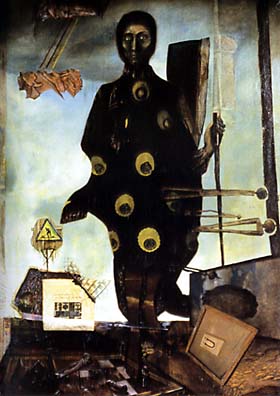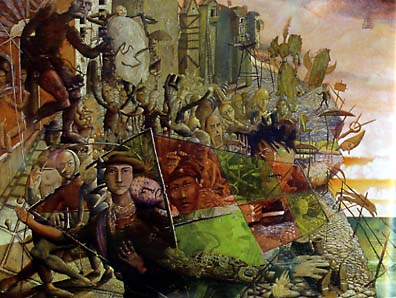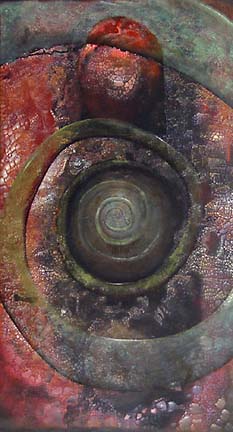
Current Issue Highlights More Readings DA Home About Direct Art

Palmlovers Arranged by the Sky, oil on canvas
A Call From Space for the artist Hawk Alfredsonby MIKA TENHOVAARA
Hawk Alfredson is on an extended sojourn in Berlin, Germany. One day the telephone rings in the apartment he’s renting. He answers. An unknown voice is heard in the receiver."You’re really doing a good job down there." The voice seems metallic, extraterrestrial.
Hawk never found out who called him, and I don’t know if the voice really belonged to an extraterrestrial being. But if they called from space it wouldn’t surprise me. You see, Hawk Alfredson’s magical paintings have an extraterrestrial character to them that probably appeals to beings from other worlds.
I got to know Hawk, or Hĺkan as he was christened, in Stockholm, the capital city of Sweden. His apartment on Katarina Bangata was filled with large, peculiar oil paintings that immediately appealed to me. No doubt about it - he was simultaneously one of the strangest of the surrealistic painters that I’d seen, and very gifted as well. How could his art have emerged in a place like this? It was like finding an amazing, glowing flower growing through the asphalt in the middle of the road.
Hawk moved to New York City a few years later, where he now resides in the celebrated Hotel Chelsea with the American photographer Mia Hanson. The chilly Swedish climate wasn’t suited for unusual art, barely even for unusual characters like Hawk. In the U.S. Alfredson found a more receptive audience.
Hawk Alfredson is a very productive artist who creates paintings in a never-ending stream, but amazingly they always have the same high quality and the same ability to surprise. One would think that surrealism had exhausted its potential to conjure up new worlds, but Hawk is one of the painters who shows that only a few percent of this inner world has been explored, like the ocean. Few people have even been to the deepest places in the oceans, let alone lived there. The ocean is like the unplumbed depths of our dreams. No one has yet succeeded in constructing a machine that can record our dreams on video, but Alfredson’s paintings provide a replacement for this serious shortage.
![]()
Icon for an Unknown Religion, oil on canvas, 38" x
32", 1999
Hawk Alfredson works almost exclusively with oil painting, and he utilizes many motifs and motif groups, where some main groups can be discerned. Something binds together almost all of Alfredson’s work, a unit I’ve chosen to call the ineffable mystery. No matter whether the motif is a chaotic group of forms or a desolate landscape, there is always a mystical presence that points to a world essentially different from the gloominess of humdrum everyday life. Hawk’s paintings are cornucopias from which you can fill up a sense of wonder enabling you to survive the sterile shallowness of mass-produced consumer society and the monotonous routine and rationality of this world that ruins the soul.
One group of paintings consists of faces in frontal perspective that look or stare directly at the spectator. Many are part of the long series of Dream Ambassadors. These dream ambassadors appear from an unknown world and often meet us with an indifferent gaze, without anything to convey except their highly conspicuous presence. In spite of their neutral tone almost all of them have a vaguely threatening character - they are in the way of the spectator and they will not budge an inch. One is hindered from gaining access ... into the world beyond the shoulders of the ambassadors.
We can begin with a few words about Dream Ambassador III, depicting a female character clad in red-black attire. Her visage emerges from the darkness of the attire with a look in her beautiful eyes that can be interpreted as understanding, but is gainsaid by the clenched, bared teeth. The picture is dominated by the figure, and we are not allowed to see anything beyond but a mystically coloured sky.
 The Enigmatic Mr Clare, Oil on canvas, 24" x 18", 1999
The Enigmatic Mr Clare, Oil on canvas, 24" x 18", 1999
The Enigmatic Mr. Clare also belongs to the group of frontal portraits and is a sibling painting to Dream Ambassador III. Mr. Clare is clad in similar attire and has a similar visage. He observes the spectator in a chilly manner and winks in an ambiguous, obscure manner. A puzzling wink - only those in the know understand and know who Mr. Clare could be.
Masculinity and femininity appear to merge in Icon for an Unknown Religion. What seems to be a yogi or guru from an unknown religion looks at us with a sublime gaze that indicates the attainment of perfect harmony. The visage is illuminated by the warm glow of such complete knowledge that the clear eyes can even pierce the world beyond the flat inanimate surface of the painting. He/she has gone beyond female or male identity and risen above the body’s constant struggle for union with another body.
The picture is easy to associate with Hindu images of saints or gods. The difference is that the religion in question is unknown to us. Both the religion and the person’s identity is a mystery, thereby restoring the original mysteriousness of religion that was kidnapped and whipped into shreds by a century of academic cruelty. In some parallel universe this yogi-guru’s image hangs on many walls as inspiration to all seekers to leave earthly struggle behind and reach unearthly bliss.
In a category of paintings more accessible and less threatening than the dream portraits, there are pictures of standing, often lonely figures. One of these is the magnificent Weaver of Implicit Material, in which a person who probably is in the midst of performing a magical act stands on a height above a gloomy landscape. With his weak hands he calls down the heavens in his obscure ritual and is accompanied by his shadow, which apparently has freed itself from him. The canvas almost makes us fall into another world - or at least we are affected by a palpable desire to do so.
 Stebuklingas Drugelis, Oil on canvas, 79" x 59" 1994
Stebuklingas Drugelis, Oil on canvas, 79" x 59" 1994
In Stebuklingas Drugelis we are met by a dark Christlike person who seems to bless the spectator. The figure is surrounded by symbolic artifacts that we are at a loss to interpret, or maybe should not interpret and thereby make worldly and demystify. When we have decharged the painting of its emotion we have nothing left but an empty intellectual exercise, no juice, just the shell.
Mayathyme can possibly be assigned to this group, even if it is a more traditional nude. Next to an old wooden chair in front of a window stands a soft-fleshed woman. One of her shoes merges with the chair. The nude’s rear part is heavily emphasized, and with its warm colors and organic, snakelike tendrils the painting is distinctly erotically charged.
These Senses Never Sleep resembles Mayathyme but is chillier with its faceless, partly naked woman standing on greenish ground with a stream that meanders towards the horizon and a mountaintop. She has a boot on one foot, the other is black and equipped with claws. What seem to be oblong pieces of dry wood mounted on a fragile structure in front of the woman hint at a vague spiritual uneasiness at the prospect of joining in intimate union with the alluring body. Mayathyme on the other hand is filled with unruly desire and lust.
A third group of paintings shows dreamlike, often chaotic scenes from nightmarish worlds. Some of these Alfredson himself calls "swarm paintings" and because of their size, complexity and wealth of detail they take many months or years to complete.
The scenes are often filled with angst and depict violence as in Palmlovers Arranged by the Sky or chaotic catastrophic situations as in Yaraia and Tight Antic II (which the artist almost named Titanic Satanic).
In Yaraia more or less deformed human forms seem to panic or celebrate in a deranged fashion on a paved street or square close to a precipice, only protected by woefully inadequate disintegrating railings. Someone is already falling to his death, watched by an amused prostrate figure, like Pulcinella from the Italian theater form of commedia dell’arte. We are face to face with the horrible ambiguity of liminality, the transitional stage between two states of being, where everything dissolves and absolutely nothing is for certain. In this inner or outer condition, mental or political revolution, we may encounter anything from an amusing incident to our own death - death of the physical body or of the body of our beliefs.
The chaotic Yaraia is far from surrealists like the sarcastic Dalí (1904-1989) or the detached, coolly observing Magritte (1898-1967). Alfredson expresses angst running riot in contrast to the constructed fantasies of Dalí. And if people in Magritte’s work are mannequins, then they are brought to life by Alfredson and are immediately stricken with existential angst.
Yaraia reminds one more of an artist like Georg Grosz (1893-1959), whose dadaistic painting Dedicated to the Poet Oskar Panizza (1917-1918) contains an equally angst-filled world, with claustrophobically leaning houses and chaotically fleeing deformed human forms. Alfredson combines this immediacy of dada with the dreamlike scenery of surrealism. The difference to many surrealists is the sense of angst and mystical presence that positively drips from the painting, more like Grosz - who also fled Europe to come to the U.S.
 Yaraia, Oil on canvas, 59" x 79, 1992
Yaraia, Oil on canvas, 59" x 79, 1992
Tight Antic II and Yaraia are also easy to compare to a medieval hell and older painters like Pieter Bruegel the Elder (1525-1569). This great artist was influenced by Hieronymus Bosch (1450-1516), who is famous for his bizarre hellish scenes. Bosch is probably another inspiration for Alfredson.
Yet another group of Alfredson’s works depict mystical objects, and these are among his most enigmatic. They are not as complex as the swarm paintings, but at least as dreamlike and surprising.
Some of the objects in these paintings are so strange that the onlooker’s gaze stays on them without finding words. Nostradamus’ Last Words depicts a greenish object, presumably batrachian, in front of a bluish background with small red marks. Is it the psychedelically transformed palm of an extraterrestrial amphibian or a coat of arms from dimension x? At least we can be assured that nothing like this exists in our own run-of-the-mill galaxy the Milky Way. Lost World is one of Alfredon’s most beautiful paintings. On brownish soil in a circle of light a possibly organic, brown object lies, pierced in two places by a spiral, which here has manifested itself in a highly palpable plantlike, spiny form. The object, the being, has been stung by the ineffable mystery. This may be an illustration of the bottomless question of consciousness about the meaning of existence, or the double pang of the realization that a world forever has been lost, mind pierced by memory.
Three recent paintings, M.F.S. I, II & III, each show a partly organic, partly mineral object against a black background. They are sculpted by an extraterrestrial civilization, are the remains of fossilized animals from another planet, are partly biological machines in hibernation that will be brought to life when the appropriate chemical signals reach them. We can only speculate about the consequences of such an activation or awakening.
The last category treated in this article is composed of abstract paintings depicting spirals, complex figures or patterns.
Innumerable cultures have used the spiral in their art. Spirals are found carved on many old stones from our early history dating from the Stone Age forward, and thus show that the symbol comes from fundamental layers of our consciousness and says something about our deepest sense of the cosmos.
The recurring spiral in the art of Alfredson may defy explanation, but it can be interpreted as a symbol of the ineffable mystery, which is otherwise only indirectly present in his paintings.
Spyral Intrusion depicts an enormous, seemingly organic transparent spiral that disappears towards a horizon of green shimmering water, into a world that seems almost paradisiacal: a stark contrast to some of the almost hellish swarm paintings. The sky can be discerned under a layer of organic, plantlike lobes that hang down from the upper edge of the painting. In the right and left corners of the picture, figures like a couple of dream ambassadors stare at the spectator. He or she can see what is beyond but probably will not get past these guardians. The picture infuses hope in a way that was not present in the swarm paintings and promises a way to continue on in contrast to the series of Dream Ambassadors, where the unyielding guardians do not let anyone pass.

The Final Transforming Stages of a Spyral Planet within a
Parallel Universe in Your Head
Oil on canvas, 62" x 36", 2001
In a painting with the baroquely exuberant title The Final Transforming Stages of a Spyral Planet Within a Parallel Universe in Your Head, a spiral disappears in a bottomless depth past lizardlike mosaic patterns in a monumental, cosmic creative act. That it could show destruction is out of the question, because the physical presence is palpable and vital - an immense power that lies behind the manifested universe.
No definitions are exact. All categories merge into one another at their borders or overlap and can be split into whichever pattern one chooses first. In other words, these temporary categorizations of Alfredson’s paintings are neither exhaustive nor final, but are a way to introduce his art to a broader public.
To describe paintings with words is like describing words with paintings. Hawk has said that his paintings are like mirrors, "the viewer relates to the images filtered through their own reality. Some see beauty where others can only see pain."
Hawk Alfredson has discovered a way into the other world, and he is a realist: he only paints what he sees there. Each new epiphany from Alfredson’s paintbrush reveals endless unimagined possibilities and shows that the world, in spite of all, has not been crushed by the reaping, purging and threshing activities of the combine-harvester of rationality. The mystery still remains, it has only become harder to find. But Hawk Alfredson is our guide and can show the way. He is not a seeker, he is a finder.
More Readings DA Home